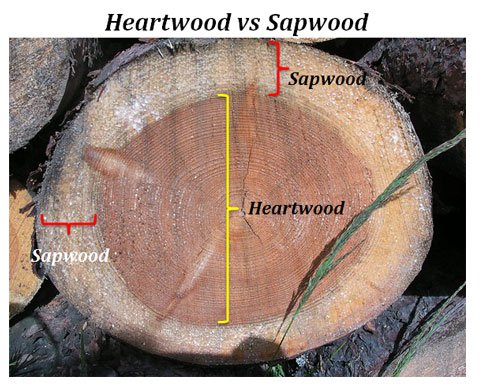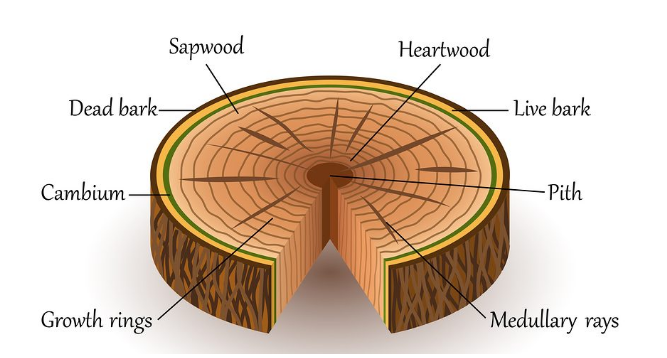What Is the Difference Between Heartwood and Sapwood Explain
The sapwood is the younger softer outer portion of a tree that lies between the heartwood and the cambium formative layer just under the bark As comparatively new wood sapwood is less durable. Heartwood is dark coloured.

13 Difference Between Sapwood And Heartwood With Table Core Differences
C Heartwood no longer transports water and minerals and sapwood still conducts xylem sap.

. The darker-colored region of the trunk is referred to as the heartwood and the lighter- colored region is called the sapwood. Its important to know about the. Heartwood is formed from old retired sapwood and becomes the strong spine of the tree.
Heartwood is preferred for woodworking as it is far less susceptible to fungus and contains much less moisture than sapwood which means it will shrink less when it dries. It is the central wood of an old stem. The central region consisting of old wood is called the heart wood or duramen.
In most woods the heartwood can be distinguished from the. If the MC percentage is too low or high your work could be damaged as the wood shrinks or expands in the process of equilibrating with its surroundings. These come in different shapes sizes and locations in the different hardwood species and this variation.
Make a comparison chart. PDF Notes Distinguish between heart wood and sapwood After a considerable period of secondary growth the secondary xylem gets differentiated into two regions. Both heartwood and sapwood hold moisture.
It is less durable because it is susceptible to attack by pathogens and insects. 2 Darker in colour. How is the primary anatomy of a root and a stem different.
Difference Between Heartwood and Sapwood Based on Uses. What is the main difference between heartwood and sapwood. Crib suggested that the pale wood was represented an initiation stage of heartwood formation.
4 It is hard and tough. In heart wood xylem parenchyma produces tyroses tracheal plugs and block the cavities of vessels. Living cells are absent.
1 It is central portion of stem. Heartwood occurs in the central portion of an old stem. The sapwood in the centre of the tree dies forming heartwood and as the cells die they release chemicals that change the colour of the wood as well as making the wood stronger and more resistant to attack by insects.
Heartwood and sapwood are composed of secondary xylem after years of secondary growth. Histological Characteristic of HeartwoodIt is known that when cambium is differentiated to sapwood prosenchyma cells are dead but ray and axial parenchyma. Heartwood is often visually distinct from the living sapwood and can be distinguished in a cross-section where the boundary will tend to follow the growth.
5 It does not perform the function of conduction of water due to formation of tyloses in vessels hence provide mechanical support. A sink is a reservoir Translocation transpiration Transpiration is the movement of liquid. What differences do you find between heartwood and sapwood.
Translocation is the movement of carbohydrates Pith wood Pith is soft and spongy. Heartwood is dead Springwood summerwood Springwood has xylem with large vessels and wider lumen Source sink A source is a process. B Sapwood contains xylem and heartwood contains phloem.
Hence the term sapwood merely expresses the function of the light colored outer growth rings in relation to the dark-colored inner rings. Differences between Heart wood and Sap wood. It is this uniformity in addition to the density of the wood which makes softwoods seem relatively soft when being sawn or machined.
Heartwood is the non-functional part of secondary xylem. D Heartwood contains old phloem that no longer functions and sapwood contains functioning phloem. In hemlock cottonwood beech aspens and all spruces with a few exceptions there is not much color difference between the heartwood and sapwood because the color of these species is usually quite light in color.
The word sap is just another term for the food that the tree conducts. Sapwood is the living outermost portion of a woody stem or branch while heartwood is the dead inner wood which often comprises the majority of a stems cross-section. Sapwood or alburnum is lighter.
The inner darker section of the trunk is the heartwood. As mentioned before the heartwood is stronger and denser than sapwood. Also it has more durability and exhibits resistance to decay rot and insect attack.
Before drying heartwood holds far less moisture than sapwood 1 but you need to account for the moisture content MC in both types of wood. Sapwood is the outer light-colored portion of a tree trunk through which the water passes from the roots to the leaves and in which excess food is often stored. All these properties make heartwood perfect for use in furniture making flooring roofing and a variety of other woodworking projects.
3 Rasins tannins gums and tyloses are found here. Based on the types of modified stems of examples of economic interest for man. A Heartwood contains xylem and sapwood contains phloem.
On the other hand the moisture is transported in hardwoods through larger diameter pores or vessels. Heartwood is the central core of the trunk. Heartwood contains far less moisture than sapwood and will have far less shrinkage when its dried.
Core Differences between Sapwood and Heartwood Sapwood is the outermost region of the wood. The key difference between heartwood and sapwood is that heartwood is found towards the centre of the trunk and contains inactive secondary xylem whereas sapwood is found near the cambium and contains active secondary xylem.

12 Difference Between Heartwood Duramen And Sapwood Alburnum Viva Differences
What Is The Difference Between Heartwood And Sapwood Pediaa Com

Heartwood Vs Sapwood Similarities Differences Easy Biology Class
Comments
Post a Comment